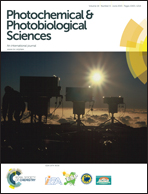Photocatalytic water disinfection by simple and low-cost monolithic and heterojunction ceramic wafers†
Abstract
In this work, the photocatalytic disinfection of Escherichia coli (E. coli) using dual layer ceramic wafers, prepared by a simple and low-cost technique, was investigated. Heterojunction wafers were prepared by pressing TiO2 and WO3 powders together into 2 layers within a single, self-supported monolith. Data modelling showed that the heterojunction wafers were able to sustain the formation of charged species (after an initial “charging” period). In comparison, a wafer made from pure TiO2 showed a less desirable bacterial inactivation profile in that the rate decreased with time (after being faster initially). The more favourable kinetics of the dual layer system was due to superior electron–hole vectorial charge separation and an accumulation of charges beyond the initial illumination period. The results demonstrate the potential for developing simplified photocatalytic devices for rapid water disinfection.



 Please wait while we load your content...
Please wait while we load your content...